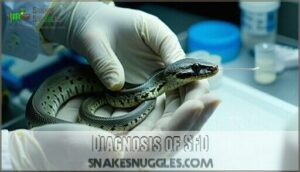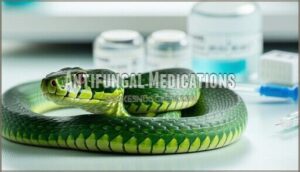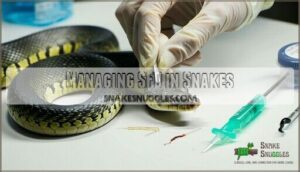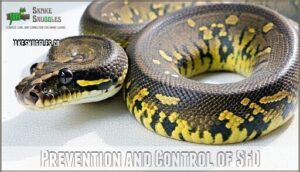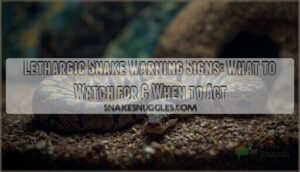This site is supported by our readers. We may earn a commission, at no cost to you, if you purchase through links.

This serious condition can spread internally, causing eye infections and pneumonia. You’ll need immediate veterinary care for proper diagnosis through skin biopsies and fungal cultures.
Treatment typically involves antifungal medications and supportive care. Clean your snake’s environment thoroughly and isolate infected animals to prevent spread.
While SFD can be fatal, early intervention improves survival odds. The key lies in understanding transmission patterns, recognizing subtle early symptoms, and implementing proven treatment protocols.
Table Of Contents
- Key Takeaways
- What is Snake Fungal Disease?
- Signs and Symptoms of SFD
- How is SFD Transmitted?
- Diagnosis of SFD
- Treatment Options for SFD
- Managing SFD in Snakes
- Mortality Rate and Prognosis
- Prevention and Control of SFD
- Other Fungal Diseases in Wildlife
- Importance of Conservation Efforts
- Frequently Asked Questions (FAQs)
- What is snake fungal disease?
- Can you get snake fungal infection from snakes?
- How do you know if a snake has fungus?
- What happens if a snake gets fungus?
- What is snake fungal disease (SFD)?
- Is snake fungal disease underreported?
- How do you treat fungal infection in snakes?
- Will a fungal infection heal on its own?
- How do you treat a fungal infection on a snake plant?
- What is the fastest way to cure a fungal infection?
- Conclusion
Key Takeaways
- Act fast when you spot symptoms – Look for facial swelling, crusty scales, skin lesions, or eye problems and get veterinary care immediately, since SFD can spread internally and become fatal without prompt treatment.
- You’ll need professional antifungal medications – Don’t try home remedies; your vet will prescribe drugs like itraconazole or voriconazole, which typically clear lesions within 2-5 weeks with proper dosing.
- Clean everything thoroughly and quarantine your snake – Disinfect the entire enclosure, replace the substrate, and isolate your infected snake for at least 30 days to prevent spreading the fungus to other reptiles.
- Early treatment dramatically improves survival odds – While SFD can have a 40% mortality rate in some cases, snakes treated quickly often recover completely, especially with proper supportive care and consistent monitoring.
What is Snake Fungal Disease?
If you’ve noticed strange skin lesions on your snake, you’re likely dealing with Snake Fungal Disease (SFD), a serious infection caused by the fungus Ophidiomyces ophiodiicola.
This disease has become a major concern for snake owners and wildlife conservationists alike, as it can spread quickly and cause significant health problems if left untreated, which is why SFD is a critical issue.
Quick action saves lives when SFD strikes—early detection and treatment are your snake’s best defense.
Causes of SFD
Understanding what causes snake fungal disease helps you protect your pet from this serious condition.
The fungal species Ophidiomyces ophiodiicola acts as an opportunistic pathogen, thriving in soil and decaying organic matter before infecting snakes through environmental contamination.
Several environmental factors increase your snake’s risk of infection:
- Contaminated soil and substrates – The fungus persists in topsoil, hibernation sites, and organic matter where snakes spend time
- Temperature and moisture conditions – Cool, moist environments promote fungal growth and survival in the habitat
- Compromised immune systems – Hibernation, stress, or injuries reduce host susceptibility and natural defenses against infection
Disease ecology shows that snakes emerging from hibernation face higher infection rates.
Snake fungal disease was first reported in 2006.
Physical damage to skin creates entry points for the fungus, while weakened immune responses during cooler months allow opportunistic infections to establish.
Understanding these disease spread patterns helps you create safer environments for your snake.
History of SFD
Snake fungal disease history traces back further than you might think.
The discovery timeline shows this sneaky pathogen has been around for decades before scientists caught on.
| Year | Milestone |
|---|---|
| 1945 | Earliest suspected case found in museum specimens |
| 1986 | First confirmed case through molecular testing |
| 2006 | Official identification in New Hampshire |
| 2008 | Ophidiomyces ophiodiicola named as causative agent |
Early outbreaks went unnoticed because researchers initially mistook SFD symptoms for other conditions.
The geographic origins point to eastern North America, though the fungus likely existed undetected across wider regions.
Research evolution accelerated once scientists developed proper diagnostic tools, leading to the naming origins of both snake fungal disease and its causative fungus, Ophidiomyces ophiodiicola.
This development was crucial for understanding the disease history and its impact on snake populations.
Species Affected by SFD
Your snake’s at risk from a disease that doesn’t discriminate. Snake fungal disease affects over 42 species across three continents, creating serious conservation concerns for vulnerable populations.
The disease, known as Ophidiomycosis, is caused by the fungus Ophidiomyces ophidiicola.
- Vulnerable Species: Eastern massasauga rattlesnakes face 90% mortality rates during outbreaks
- Geographic Distribution: Found in 19 U.S. states, Puerto Rico, Canada, and Europe
- Population Declines: Lake Erie watersnakes dropped 18% following disease outbreaks
- Conservation Status: Threatens genetic diversity in timber rattlesnakes and copperheads
Signs and Symptoms of SFD
If you suspect your snake has a fungal infection, recognizing the early warning signs can make the difference between successful treatment and serious complications.
Snake Fungal Disease presents with distinct visual symptoms that every reptile owner should know how to identify.
Facial Swelling and Lesions
Among the most telling signs of snake fungal infection, facial swelling stands out as a red flag that demands immediate attention.
This swelling typically appears alongside several concerning symptoms that indicate lesion severity and potential tissue damage.
Key facial symptoms to watch for:
- Nodules or lumps – These raised bumps often cluster around the snout and jaw areas
- Ulcerative lesions – Open sores that create entry points for secondary infections
- Crusted, thickened skin – Resembling scaly patches that worsen without treatment
The swelling location typically centers around the face, particularly near the eyes and mouth.
Pain assessment becomes vital as these lesions can substantially impact your snake’s feeding and overall comfort.
Skin Ulcerations and Crusting
The telltale signs of snake fungal infection often appear as skin ulcerations and crusted scales that worsen over time.
These fungal infection symptoms create rough, thickened patches where healthy scales once were.
Ulcer severity varies, but crusting location typically affects the head and body areas.
Scale damage opens doors to secondary infections, complicating the healing process.
Watch for these snake skin infection warning signs.
Eye Infections and Pneumonia
Two serious complications can emerge from snake fungal disease: corneal ulcerations and respiratory distress.
Watch for these warning signs that require immediate snake vet attention:
- Vision impairment from cloudy, opaque eyes indicating corneal damage
- Respiratory distress with wheezing or labored breathing patterns
- Secondary infections developing from compromised immune systems
- Aspiration pneumonia causing severe snake health problems requiring emergency care
How is SFD Transmitted?
Understanding how your snake contracted this fungal infection helps prevent future outbreaks and protects other reptiles in your care.
Snake Fungal Disease spreads through three main pathways: environmental contamination from infected soil and surfaces, direct contact with contaminated water sources, and transmission between snakes through close contact or shared equipment, which can be considered as direct contact or through contaminated water.
Environmental Contamination
Environmental contamination creates hidden pathways for SFD transmission that you might overlook.
Fungal reservoirs develop in soil composition and water sources, while human impact and climate change affect environmental hygiene. Your outdoor equipment can transfer spores between locations.
The disease, caused by Ophidiomyces ophiodiicola fungus, leads to severe skin infections.
| Contamination Source | Prevention Method |
|---|---|
| Contaminated surfaces | Regular disinfection protocols |
| Soil reservoirs | Avoid high-risk areas |
| Water sources | Test and treat water systems |
| Equipment transfer | Clean gear between uses |
Maintaining cleanliness in your snake’s environment requires understanding these contamination routes and implementing proper hygiene measures.
Soil and Water Contamination
Soil and water harbor fungal spores that threaten your snake’s health.
Contaminated surfaces from runoff impact and irrigation concerns create breeding grounds for Ophidiomyces ophiodiicola.
Environmental survival means spores persist in moist conditions, making environmental hygiene critical.
Fungal persistence in soil requires remediation strategies like proper drainage and substrate replacement to protect your pet.
Snake-to-Snake Transmission
While soil and water create fungal hotspots, snake-to-snake transmission poses another serious threat through direct contact and contaminated surfaces.
Infected snakes shed the pathogen, creating asymptomatic carriers who spread disease unknowingly.
Key transmission risks include:
- Direct contact between snakes during social behavior or breeding
- Contaminated surfaces in shared enclosures or handling equipment
- Shedding transmission from infected skin scales to healthy snakes
Diagnosis of SFD
If you suspect your snake has a fungal infection, getting an accurate diagnosis is the first step toward effective treatment.
Veterinarians use several testing methods, including laboratory tests, skin biopsies, and DNA analysis, to confirm the presence of Ophidiomyces ophiodiicola and rule out other conditions.
Laboratory Testing
Laboratory testing provides the most accurate diagnosis for snake fungal disease.
Your veterinarian will collect samples through swabbing visible lesions, which yields an 80-82% detection rate.
DNA analysis using PCR testing identifies Ophidiomyces ophiodiicola with high precision, while fungal culture and histopathology confirm species identification.
| Diagnostic Method | Detection Rate |
|---|---|
| Lesion swab PCR | 80-82% |
| Tissue biopsy analysis | 97.5% |
| Visual assessment only | 58% |
| Multiple swab sites | Higher accuracy |
| Fungal culture | Variable timing |
Skin Biopsy and Fungal Culture
Skin biopsy represents the gold standard for confirming SFD diagnosis. Your veterinarian will collect tissue samples from affected areas using sterile biopsy techniques, then send them to specialized laboratories for fungal culture and identification.
- Sample handling requires sterile collection methods to prevent contamination during transport
- Culture mediums allow fungal growth over several weeks for accurate identification
- Fungal identification involves microscopic examination and biochemical testing of grown organisms
- Result interpretation helps determine specific treatment protocols based on fungal species detected
DNA Detection and PCR
Modern PCR methods give you the most accurate diagnosis for snake fungal infection.
DNA sequencing and qPCR techniques detect even tiny amounts of fungal genetic material from skin samples, making this the gold standard for confirming SFD.
DNA Detection Process:
- PCR primers target specific Ophidiomyces ophiodiicola genes for precise identification
- Genetic diversity analysis helps determine fungal strain and treatment resistance
- Environmental DNA testing can detect contamination in your snake’s habitat
- Diagnostic methods combine skin biopsy results with molecular confirmation for certainty
Treatment Options for SFD
When your snake develops a fungal infection, quick action with proper treatment can make the difference between recovery and serious health complications.
Treatment options range from antifungal medications to supportive care, with the best approach depending on how severe the infection has become.
Antifungal Medications
Several antifungal medications effectively treat snake fungal infections.
Itraconazole, given orally at 5 mg/kg daily, resolves lesions within 14-37 days. Voriconazole efficacy surpasses itraconazole but may cause neurotoxicity.
Terbinafine resistance remains low, making it reliable for systemic antifungals and topical application. Slow-release therapies and combination treatments improve outcomes while reducing recurrence rates.
Many owners purchase itraconazole here for their snakes.
Supportive Care and Nutritional Support
Beyond antifungal medications, supportive care and nutritional support form the backbone of snake fungal disease recovery. Your snake’s immune system needs every advantage to fight this infection effectively.
Proper supportive care involves creating an environment where healing thrives. Think of it as building a recovery sanctuary for your pet.
Here’s what your snake needs:
- Optimal Temperature: Maintain temperatures between 75-85°F to support metabolic functions and immune response during treatment.
- Hydration Strategies: Provide fresh water daily and consider soaking sessions to prevent dehydration, especially if appetite decreases.
- Appetite Stimulation: Offer appropriately-sized prey items and monitor feeding response, as proper nutrition fuels recovery. Snakes with fungal infections may also be experiencing vitamin A deficiency, impacting their overall health.
- Wound Care: Keep enclosures spotless and monitor affected areas for signs of improvement or complications.
Topical Treatments and Surgery
When topical application isn’t enough, surgical debridement becomes your snake’s lifeline.
Antifungal medications paired with surgical intervention can tackle stubborn lesions that won’t budge.
Debridement techniques remove infected tissue, while proper lesion care prevents post-op infection.
Though scarring reduction takes time, combining topical treatments with surgery often delivers the best outcomes for snake fungal infection recovery, and surgical debridement is crucial, as it helps in tackle stubborn lesions.
Managing SFD in Snakes
Once you’ve established that your snake has a fungal infection, proper management becomes essential for recovery and preventing spread to other animals.
Effective management involves three key areas: thorough environmental cleaning, strict quarantine protocols, and careful monitoring to track the infection’s progress.
Environmental Cleaning and Disinfection
Enclosure Disinfection starts with removing your snake completely.
Clean all surfaces with reptile-safe disinfectants like chlorhexidine or F10SC.
Equipment Cleaning includes scrubbing hides, bowls, and décor thoroughly.
Replace substrate entirely—Soil Treatment prevents spore buildup.
Water Sanitation requires fresh, dechlorinated water daily.
For a variety of options, consider reptile-safe disinfectant products.
Habitat Maintenance through proper environmental control and consistent habitat hygiene creates an inhospitable environment for fungal growth.
Quarantine and Isolation Protocols
Following an infected snake’s diagnosis, implementing proper quarantine and isolation protocols protects your other reptiles from contamination.
Here’s what you need to know:
- Quarantine Length: Maintain isolation for minimum 30 days, extending if symptoms persist
- Isolation Environment: Use separate room with dedicated ventilation, temperature control, and biosecurity measures
- Handling Protocols: Wash hands thoroughly, use disposable gloves, and disinfect all equipment between animals
- Reducing Stress: Provide hiding spots, consistent lighting, and minimal disturbance during treatment
- Monitoring Health: Check daily for symptom changes, appetite, and behavior patterns
Always consult your veterinarian for specific guidance on preventive measures in captive environments.
Monitoring and Tracking SFD Outbreaks
Wildlife health experts’ surveillance systems track snake fungal disease outbreaks through coordinated reporting protocols and predictive modeling.
You’ll find data analysis reveals spread patterns across snake populations, helping researchers assess outbreak severity.
Disease monitoring relies on standardized reporting from field biologists and the public to map disease surveillance effectively.
| Monitoring Component | Method | Purpose |
|---|---|---|
| Geographic Mapping | GPS tracking of cases | Identify outbreak hotspots |
| Data Collection | Standardized reporting forms | Track spread patterns consistently |
| Predictive Analysis | Environmental modeling | Forecast future outbreak zones |
Mortality Rate and Prognosis
Understanding your snake’s prognosis depends on several key factors, including how quickly you start treatment and your snake’s overall health.
While SFD can be serious, many snakes recover well with proper antifungal treatment and supportive care.
Survival Rates and Recovery Time
Your snake’s survival rate with snake fungal disease varies dramatically by species and conditions.
Experimental studies show 40% mortality rates, with infected snakes averaging 90 days from infection to recovery or death.
However, Species Resilience differs substantially – some pygmy rattlesnakes recovered completely while eastern massasaugas face 95% mortality.
Recovery Indicators include multiple rapid molts and improved appetite, suggesting positive Long-Term Health outcomes for survivors.
Factors Affecting Survival and Prognosis
Your snake’s chances of beating this infection depend on several key factors that you can influence:
Your snake’s survival depends on early detection, proper treatment, and your commitment to care.
- Species susceptibility – Some snake species show stronger immune responses and better treatment effectiveness than others
- Severity of infection – Early-stage infections respond much better than advanced cases with widespread complications
- Environmental factors – Poor husbandry conditions worsen snake fungal infection prognosis and extend duration
Snake fungal infection vulnerability varies substantially based on these elements, making early intervention your best strategy for recovery.
The disease, known as SFD snake fungal disease, has a 40% mortality rate.
Long-term Effects of SFD
SFD’s lasting impact on your snake goes beyond initial recovery.
Immune suppression weakens their defenses against future infections, while reproduction impact affects breeding success.
Population decline threatens species survival when multiple snakes suffer these effects.
Habitat alteration compounds problems, creating ecological impact throughout the ecosystem.
Conservation efforts must address reduced genetic diversity in affected snake populations.
| Long-term Effect | Impact on Snake Health |
|---|---|
| Immune Suppression | Increased vulnerability to secondary infections |
| Reproduction Impact | Reduced fertility and breeding success |
| Population Decline | Fewer breeding individuals in ecosystem |
| Habitat Alteration | Contaminated environments affect species survival |
Prevention and Control of SFD
Preventing snake fungal disease starts with maintaining excellent hygiene and creating a clean environment for your snake.
You’ll need to disinfect equipment regularly, quarantine new snakes, and avoid direct contact with infected animals to protect your pet from this serious fungal infection, specifically snake fungal disease.
Good Hygiene Practices
Prevention starts with Hand Hygiene—wash thoroughly before and after handling your snake.
Enclosure Cleaning should happen weekly using reptile-safe disinfectants. Change substrate regularly for proper Substrate Management.
Water Sanitation means fresh, clean water daily. Quarantine Procedures require isolating new snakes for thirty days.
These snake care tips create a foundation for preventing snake fungus through consistent husbandry practices.
Disinfecting and Cleaning Equipment
Your gear can become a highway for fungal spores if you’re not careful. Equipment Disinfection starts with choosing the right Cleaning Solutions – antifungal disinfectants work best against snake fungal infection.
Practice Safe Handling by wearing gloves and cleaning boots, nets, and containers after each use. Consider using antifungal cleaning products for effective disinfection.
Preventative Maintenance includes air-drying gear completely before storage. Proper Disposal Methods for contaminated materials protect other snakes from infection.
Avoiding Contact With Infected Snakes
Wild encounters pose the greatest risk for disease transmission.
Safe handling protocols require gloves and thorough handwashing after contact with any snake.
Implement quarantine procedures for new animals before introducing them to existing collections.
Habitat awareness helps you identify potentially infected populations.
Preventative measures include avoiding movement of animals between locations.
Public education promotes biosecurity and disease prevention through responsible handling practices.
Other Fungal Diseases in Wildlife
While your snake battles its fungal infection, it’s not alone in the wildlife world facing similar threats.
Fungal diseases like white-nose syndrome in bats, chytridiomycosis in frogs, and Bsal in salamanders are quietly devastating animal populations across the globe.
Making your pet’s condition part of a much larger conservation crisis.
White-nose Syndrome in Bats
While snake fungal disease affects reptiles, white-nose syndrome devastates North American bat populations.
This fungal infection, caused by Pseudogymnoascus destructans, has killed over 6.7 million bats since 2006.
The fungus invades hibernating bats’ skin, disrupting their cave ecology and bat behavior.
Mortality rates reach 90-100%, making this the worst wildlife disease outbreak in North American history, requiring urgent conservation impact measures.
Chytridiomycosis in Amphibians
Frogs face a devastating threat from Batrachochytrium dendrobatidis, a fungus causing chytridiomycosis that’s reshaping amphibian populations worldwide.
This wildlife disease has triggered massive amphibian decline, affecting over 700 species across continents. Understanding its global spread helps contextualize fungal infections in reptiles and other wildlife diseases.
Key impacts include:
- Species extinction: Chytridiomycosis has caused the decline or extinction of approximately 200 amphibian species globally
- Widespread infection: The fungus affects over 700 amphibian species across all continents where amphibians occur
- Conservation crisis: The disease represents one of the most significant threats to global biodiversity, requiring urgent prevention strategies and veterinary medicine interventions
This fungal pathogen demonstrates how disease management challenges extend beyond reptiles to encompass broader conservation impact across wildlife populations.
Bsal in Salamanders
Although salamanders face their own fungal threat, Bsal (Batrachochytrium salamandrivorans) devastates European populations with fatal skin erosion.
This chytrid fungus spreads through international amphibian trade, affecting over twenty species.
While reptile veterinarians focus on antifungal treatments for snakes, researchers develop conservation strategies to prevent Bsal’s spread to North America, protecting vulnerable salamander populations from this deadly pathogen.
Importance of Conservation Efforts
When you understand how fungal diseases affect your snake, you’re contributing to larger conservation efforts that protect reptile populations worldwide.
Your actions in treating and preventing snake fungal disease help scientists gather valuable data that supports research initiatives aimed at preserving biodiversity and protecting vulnerable wildlife species from emerging threats, which ultimately supports conservation efforts.
Threats to Global Biodiversity
Beyond snake fungal disease, wildlife faces mounting pressures threatening global biodiversity.
Our planet’s interconnected ecosystems are experiencing unprecedented challenges that affect snake populations and countless other species.
Ecosystem Impacts from multiple threats create cascading effects:
- Habitat Loss fragments wildlife corridors, isolating populations and reducing genetic diversity across species ranges
- Climate Change shifts temperature patterns, altering breeding cycles and food availability for snake populations worldwide
- Species Extinction accelerates as fungal infections combine with environmental stressors to overwhelm vulnerable wildlife
- Conservation Strategies must address these interconnected challenges to protect ecosystem stability and biodiversity
These threats don’t operate in isolation – they compound each other, creating perfect storms for wildlife decline.
Protecting Vulnerable Wildlife Populations
Wildlife conservation efforts require your active participation to protect vulnerable species from threats like snake fungal disease.
Conservation strategies depend on habitat preservation and maintaining genetic diversity in snake populations.
Here’s how you can help:
- Support habitat preservation projects in your local area
- Advocate for policy enforcement protecting wildlife corridors
- Raise public awareness about ecosystem health importance
- Volunteer with wildlife conservation organizations conducting research
Collaboration and Research in Conservation
Conservation efforts thrive when scientists, government agencies, and citizens work together.
You can join citizen science projects to help track snake fungal disease outbreaks. These partnerships improve data sharing between research teams and help set funding priorities.
Interdisciplinary teams combine expertise from veterinarians, ecologists, and pathologists. Global networks connect researchers worldwide, strengthening wildlife conservation through shared knowledge and resources.
Swamp snakes, for example, play crucial roles in wetland ecosystems.
Frequently Asked Questions (FAQs)
What is snake fungal disease?
Like a silent intruder creeping through your pet’s world, snake fungal disease strikes when you least expect it.
This infection, caused by Ophidiomyces ophiodiicola, creates crusty lesions, facial swelling, and abnormal shedding patterns that can seriously threaten your snake’s health.
Can you get snake fungal infection from snakes?
Snake fungal disease typically doesn’t transmit from snakes to humans. You’re safe handling your infected snake with basic hygiene precautions like washing hands afterward.
How do you know if a snake has fungus?
You’ll spot crusty scales, facial swelling, cloudy eyes, scaly patches, and abnormal shedding patterns. Look for localized scabs, thickened skin lesions, blisters, and ulcerations on your snake’s body.
What happens if a snake gets fungus?
Fungal infections cause serious skin problems in snakes, including crusty scales, facial swelling, and ulcerations. Without treatment, your snake can develop severe lesions and potentially die from complications.
What is snake fungal disease (SFD)?
When trouble strikes like a silent thief, Snake Fungal Disease (SFD) becomes your reptile’s worst nightmare.
This serious infection, caused by Ophidiomyces ophiodiicola fungus, creates crusty lesions, facial swelling, and abnormal shedding patterns that can threaten your snake’s health, making it a serious threat.
Is snake fungal disease underreported?
Yes, you’re likely dealing with underreported cases. Many infections go undiagnosed because symptoms can be subtle initially, and not all snake owners seek veterinary care promptly when issues arise.
How do you treat fungal infection in snakes?
When your ball python develops cloudy eyes and scaly patches, you’ll need antifungal medications like voriconazole or terbinafine, applied topically or systemically, plus supportive care with proper temperature and humidity.
Will a fungal infection heal on its own?
Snake fungal infections won’t heal on their own and typically worsen without treatment. You’ll need antifungal medications like voriconazole or terbinafine to effectively combat the infection and prevent serious complications.
How do you treat a fungal infection on a snake plant?
I notice there’s a mismatch between your context (snake with fungal infection) and your current question about treating a fungal infection on a snake plant.
I’ll address your question about the snake plant. For snake plants with fungal infections, you’ll need to remove affected leaves, improve air circulation, reduce watering frequency, and apply fungicide treatment to healthy parts.
What is the fastest way to cure a fungal infection?
Racing against time’s relentless clock, you’ll need swift action to combat fungal infections.
Consult your veterinarian immediately for proper antifungal medications like voriconazole or terbinafine, which offer the fastest, most effective treatment results.
Conclusion
Unfortunately, even the most dedicated snake parent can’t shield their scaly friend from every microscopic menace lurking in the environment.
When your snake has a fungal infection, swift action and proper veterinary care make the difference between recovery and tragedy.
Don’t attempt home remedies or delay treatment, as SFD progresses rapidly and can cause permanent damage.
Follow your veterinarian’s treatment plan precisely, maintain strict hygiene protocols, and monitor your snake closely throughout recovery for the best possible outcome, ensuring you take swift action.
- https://en.wikipedia.org/wiki/Polymerase_chain_reaction
- https://www.sciencedirect.com/topics/immunology-and-microbiology/onygenales
- https://pubs.er.usgs.gov/publication/fs20173064
- https://pmc.ncbi.nlm.nih.gov/articles/PMC5095536/
- https://miller-mycology-lab.inhs.illinois.edu/files/2020/04/Ophidiomyces-ophiodiicola-Allender-et-al-Fungal-Ecology-2015.pdf





